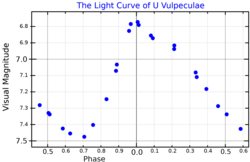U Vulpeculae
| Observation data Epoch J2000.0 Equinox J2000.0 | |
|---|---|
| Constellation | Vulpecula |
| Right ascension | 19h 36m 37.7281s[2] |
| Declination | 20° 19′ 58.5692″[2] |
| Apparent magnitude (V) | 6.73 - 7.54[3] |
| Characteristics | |
| Spectral type | F6Iab-G2[4] |
| Variable type | δ Cep[3] |
| Astrometry | |
| Proper motion (μ) | RA: 0.906±0.050[2] mas/yr Dec.: −0.960±0.062[2] mas/yr |
| Parallax (π) | 1.0530 ± 0.0390 mas[2] |
| Distance | 3,100 ± 100 ly (950 ± 40 pc) |
| Absolute magnitude (MV) | -3.69[5] |
| Orbit[6] | |
| Period (P) | 2,510 days |
| Eccentricity (e) | 0.675 |
| Periastron epoch (T) | 2444800 |
| Argument of periastron (ω) (secondary) | 353° |
| Semi-amplitude (K1) (primary) | 3.64 km/s |
| Details | |
| Mass | 6.5[7] M☉ |
| Radius | 60[7] R☉ |
| Surface gravity (log g) | 1.75 - 1.85[8] cgs |
| Temperature | 5,655 - 5,965[8] K |
| Metallicity [Fe/H] | 0.09[9] dex |
| Age | 82[9] Myr |
| Other designations | |
| Database references | |
| SIMBAD | data |
U Vulpeculae is a variable and binary star in the constellation Vulpecula.
It is a classical Cepheid variable and its apparent magnitude ranges from 6.73 to 7.54 over a precise cycle of 7.99 days.[4] Its variable nature was discovered in 1898 at Potsdam Observatory by Gustav Müller and Paul Kempf.[11]
In 1991 a study of radial velocities showed that it U Vulpeculae is a spectroscopic binary and a full orbit with a period of 2510 days (6.9 years) was first calculated in 1996.[12][7] The secondary star is invisible and is only known from its effect on the motion of the primary.[6]
References
- ^ Kiss, Laszlo L. (July 1998). "A photometric and spectroscopic study of the brightest northern Cepheids - I. Observations". Monthly Notices of the Royal Astronomical Society. 297 (3): 825. Bibcode:1998MNRAS.297..825K. doi:10.1046/j.1365-8711.1998.01559.x.
- ^ a b c d e Brown, A. G. A.; et al. (Gaia collaboration) (August 2018). "Gaia Data Release 2: Summary of the contents and survey properties". Astronomy & Astrophysics. 616. A1. arXiv:1804.09365. Bibcode:2018A&A...616A...1G. doi:10.1051/0004-6361/201833051. Gaia DR2 record for this source at VizieR.
- ^ a b Samus, N. N.; Durlevich, O. V.; et al. (2009). "VizieR Online Data Catalog: General Catalogue of Variable Stars (Samus+ 2007-2013)". VizieR On-line Data Catalog: B/GCVS. Originally Published in: 2009yCat....102025S. 1: B/gcvs. Bibcode:2009yCat....102025S.
- ^ a b Watson, Christopher (4 January 2010). "U Vulpeculae". AAVSO Website. American Association of Variable Star Observers. Retrieved 2 August 2015.
- ^ Kovtyukh, V. V.; Chekhonadskikh, F. A.; Luck, R. E.; Soubiran, C.; Yasinskaya, M. P.; Belik, S. I. (2010). "Accurate luminosities for F-G supergiants from FeII/FeI line depth ratios" (PDF). Monthly Notices of the Royal Astronomical Society. 408 (3): 1568. Bibcode:2010MNRAS.408.1568K. doi:10.1111/j.1365-2966.2010.17217.x.
- ^ a b Groenewegen, M. A. T. (2008). "Baade-Wesselink distances and the effect of metallicity in classical cepheids". Astronomy and Astrophysics. 488 (1): 25–35. arXiv:0807.1269. Bibcode:2008A&A...488...25G. doi:10.1051/0004-6361:200809859. S2CID 13871801.
- ^ a b c Imbert, M. (1996). "Cepheids and binarity. II. Radial velocities and spectroscopic orbits of four galactic Cepheids: RX Camelopardalis, MW Cygni, Z Lacertae and U Vulpeculae". Astronomy and Astrophysics Supplement (in French). 116: 497–514. Bibcode:1996A&AS..116..497I. doi:10.1051/aas:1996312.
- ^ a b Andrievsky, S. M.; Lépine, J. R. D.; Korotin, S. A.; Luck, R. E.; Kovtyukh, V. V.; MacIel, W. J. (2013). "Barium abundances in Cepheids". Monthly Notices of the Royal Astronomical Society. 428 (4): 3252. arXiv:1210.6211. Bibcode:2013MNRAS.428.3252A. doi:10.1093/mnras/sts270.
- ^ a b Marsakov, V. A.; Koval', V. V.; Kovtyukh, V. V.; Mishenina, T. V. (2013). "Properties of the population of classical Cepheids in the Galaxy". Astronomy Letters. 39 (12): 851. Bibcode:2013AstL...39..851M. doi:10.1134/s1063773713120050. S2CID 119788977.
- ^ "U Vulpeculae". SIMBAD. Centre de données astronomiques de Strasbourg. Retrieved 2 August 2015.
- ^ Müller, G.; Kempf, P. (1898). "Zwei neue Veränderliche von kurzer Periode". Astronomische Nachrichten (in German). 146 (3): 37–42. Bibcode:1898AN....146...37M. doi:10.1002/asna.18981460303.
- ^ Szabados, L. (1991). "Northern Cepheids: Period Update and Duplicity Effects". Communications of the Konkoly Observatory. 11 part 3 (96): 123–244. Bibcode:1991CoKon..96..123S.

